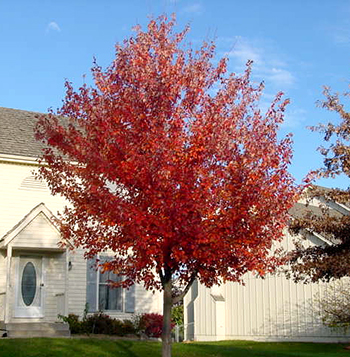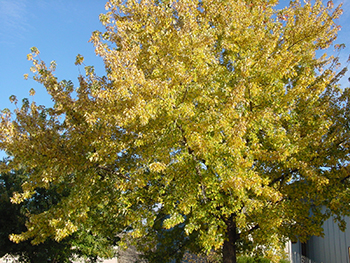Tree Selection for Kansas City: Avoid these mistakes
Return to Trees and Shrubs Agent Articles
 The best time to plant a tree was 20 years ago. The next best time is now. This popular saying has been around for years. I have quoted it more times than I can count. Over the years I have written extensively on selecting and planting the perfect tree. Unfortunately not everyone has gotten the word on what is a recommended tree for the Kansas City area.
The best time to plant a tree was 20 years ago. The next best time is now. This popular saying has been around for years. I have quoted it more times than I can count. Over the years I have written extensively on selecting and planting the perfect tree. Unfortunately not everyone has gotten the word on what is a recommended tree for the Kansas City area.
You might ask why I make this statement. Well, driving around the city I have seen some of the boneheaded choices that people have made. That made me think; maybe I should pen a column not about recommended trees but instead use the reverse approach. That would be a column on what not to plant. Call out the dogs of the tree world and help people make wiser choices.
Being so bold as to naming the poor tree choices for our area runs the risk of offending people. Who, might you ask, would be against cautioning people from making a mistake? I can quickly think of two groups I will offend. One is the people that have already made and planted the poor choice. The other group I am sure to offend is the garden centers that will have these trees in stock and ready to sell. How dare I kill a sale? Personally I don’t look at it as preventing a sale but instead as helping customers make informed decisions so that they get the best possible selection for their investment of time and money.
What makes a great tree
In order to determine what trees not to plant I think we need to look at what makes a great tree. A tree for the home landscape should have several desirable qualities. The most important quality for a tree that will grow large and planted for shade is it should have a strong growth habit. It should resist breaking up in an ice or wind storm. A great tree should not have any issues with insects or disease that would require treatments or harm growth.
Outside of those two factors all the other selection criteria is more about personal choice. I want fall color or flowers. I don’t want any fruit or thorns. I want a fast growing tree with no surface roots. Granted these are all desirable characteristics but sometimes we focus too much on these cosmetic attributes and forget the fact that the tree needs to survive the ever-changing forces of Kansas City weather. What’s more important, a tree that will not fall on your house in a storm or a tree that has pretty fall color for less than two weeks out of the year? Unfortunately we often make the decision on the latter instead of thinking year-round and year after year.
The unfortunate lesson learned from our ash trees
Many of us, while not happy about it, will be planting new trees as Emerald Ash Borer (EAB) continues its march across the metro. I am in this boat. I keep asking myself what tree I will select to replace my almost 25-year-old green ash. It is easier to list all the trees that I won’t be planting. So here goes with the list of trees to avoid. Some of these are very obvious but people still plant them.
Avoid planting these trees for Kansas City
Fast growers
People seem to always want fast growing trees. We are a society of instant gratification. We want it now, so in this zest we put growth rate at the top of the wish list. In reality it should not be part of the discussion, as a slow growing tree with proper care can be sped up and still retain its benefits. As a rule, fast growing trees are weak wooded, tend to break under wind and ice, easily develop defects including rot and decay, and, in the scheme of life, tend to live for a shorter period of time.
Willows
Fast growing trees to avoid for the suburban home landscape include all species of willows. Yes, I realize weeping willows are pretty but they just don’t make it in a backyard. Another willow tree is a hybrid called the Aust tree. Aust trees are usually not found at our local garden centers, but instead in those too good to be true offers in the newspapers or magazines.
Cottonwood and poplars
Avoid members of the poplar or cottonwood family. Even though cottonwood is the Kansas state tree it is probably best left to tower over the stream banks. In the landscape, fast growing poplar species break in storms, develop canker diseases which leads to limb dieback and are prone to borers. As the tree ages, they will fail and become landscape eyesores. Maples: silver, red and Freemans
Maples: silver, red and Freemans
The last group of trees I will put on my avoid list are ones that will get me in trouble. On my do not plant list are several species of maples. I will start with the least controversial, silver maple. This long available tree is a nice specimen, but due to the fact that it is soft-wooded it does not show its true colors until it is mature. At that point limbs will break in storms and then decay develops which leads to defects and a costly unwanted removal.
Those that have read my writing know what is coming next. I do not recommend red maples. Red maples have probably been the most commonly planted tree over the last 20 years. There is good enough reason not to plant red maple. Any species that is over planted in an area is more prone to insect and disease outbreaks. Remember the destruction from Dutch elm disease and EAB? Both occurred from overplanted species. So what does the future hold for this maple?
Red maple as a young tree is highly susceptible to trunk injury. Look at it closely — it cracks, splits and dies resulting in rot and decay. I have lost track of the number of photos of sickly red maple trunks that have come into our office. "What can I do to save my tree?," I am asked. The honest answer is purchase some hotdogs and marshmallows and have a bonfire. There is no saving the tree.
Now to make matters worse the industry said, "Let’s cross the silver maple for its growth habit with the red maple for its fall color and produce a new tree!" Now we have a fast growing, soft wooded tree with fall color. Yeah, that will sell, and boy has it. But why did anyone ever think that two inferior parents would produce a better offspring? I do not recommend Freeman's maple.
As you can see some of our most popular and well-known trees are on my hit list. (And don't get me started on those blankety-blank ornamental pears!)
I think many people just fall prey to what they know or what is familiar. It is comfortable, easy, and doesn’t require thought or an investment. But selecting a tree is an investment, not just today but for 20, 30, 40 years or more. Would you purchase your home because it is easy? No, you would research the area, schools, and crime rate. You wouldn’t just walk in and say, “I’ll take this one.”
Don’t become a tree settler just because you recognize the name or your neighbor planted one. There are lots of wonderful trees of all sizes and all aspects that do well here in Kansas City. Do your homework and make sure that the tree you planted today will be here tomorrow for future generations to enjoy.

